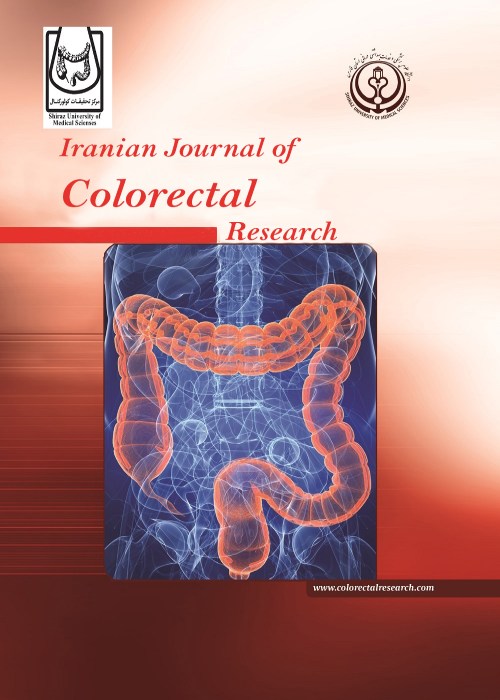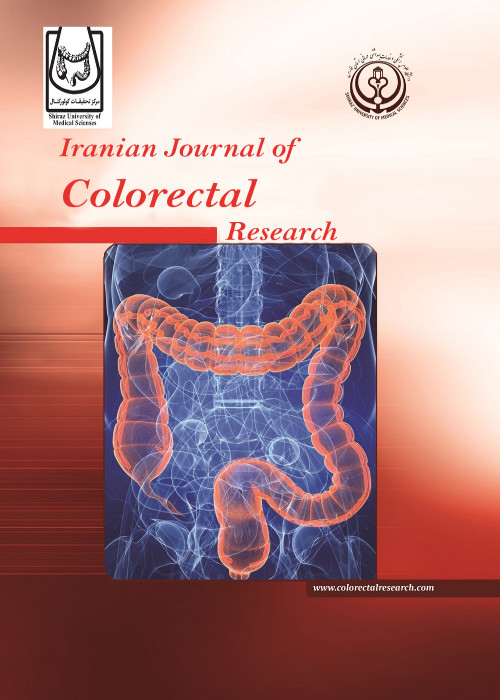فهرست مطالب

Iranian Journal of Colorectal Research
Volume:11 Issue: 1, Mar 2023
- تاریخ انتشار: 1402/04/13
- تعداد عناوین: 8
-
-
Page 1Purpose
The current investigation was conducted with the aim to elucidate and determine the anti-cancer efficacy in vitro on colon carcinoma human cell lines and to determine its probable mode of action.
MethodAnti-proliferative and apoptotic effect of various doses of essential oil from Ferula asafoetida was investigated on colon cancer cell lines i.e. CW620 and CT26. WT. The percentage cytotoxicity was determined by MTT assay. In addition, expression studies were carried out to determine the mode of action by determining the levels of NF-kB, TNF-alpha, TGF-beta and Caspases.
ResultThe potent anti-proliferative activity has been observed in both the cell lines. The percentage cytotoxicity is directly proportional to the increasing concentration of the essential oil. The same was also confirmed in the expression studies which shows significant upregulation of the antiapoptotic characteristics and down regulation of pro-carcinogenic factors.
ConclusionThe essential oil shows potent anti-cancer activity and shows the role in gene regulation to attenuate the colon cancer.
Keywords: Colon Cancer, Ferula asafoetida, Essential oil, anti-cancer properties, Caspases, Inflammation -
Page 2
Vaginal metastasis from colorectal adenocarcinoma can occur months after the resection of the primary tumor. Most of the time, bleeding is the bothersome symptom. The optimal treatment involves surgical excision followed by reconstruction to prevent the lymphatic networks in the rectovaginal septum serving as a potential route of spread. There have been a number of successful vaginal reconstructive options reported. We describe a 32-year-old woman who had previously undergone an abdominoperineal resection for rectal cancer and was now suffering with rectal adenocarcinoma vaginal metastases. An inferior gluteus perforator flap (IGAP) repair was carried out following posterior vaginectomy after a comprehensive multidisciplinary examination. This flap can be used to address perineal dead space as well as to reconstruct the neovaginal area, eliminating the need for a second flap and significantly reducing donor morbidity. The lesson from this case is that vaginal metastases can still develop even after the primary colorectal tumor has been removed. One-step surgical excision and perineal repair can result in an enhanced quality of life and a good prognosis.
Keywords: Vaginal metastasis, Rectal Cancer, IGAP, Vaginal reconstruction -
Page 3Introduction
Diverticulitis is inflammation of one or more adjacent diverticulums and the surrounding colon. Patients with diverticulitis typically present acute or subacute abdominal pain in the left lower quadrant. Most patients with diverticulitis are over 50; however, diverticulitis is increasingly common in the younger. Diverticulitis may present with acute abdomen by causing intra-abdominal perforation. Although it is infrequent, diverticulitis perforation should be considered in the differential diagnosis of young patients with acute abdomen.
Case PresentationIn this case, we present the acute abdomen secondary to diverticulitis perforation in a 23-year-old male patient. The patient's physical examination and computed tomography scan were interpreted as perforation. We performed explorative laparotomy. In the operation, the stomach and other lumen organs were intact. It was observed that there were diverticula in the sigmoid colon, intense inflammation in the colon serosa in the region of the diverticula, and a perforation area of 1 cm in diameter.
ConclusionsDiverticulitis usually presents with abdominal pain in the left lower quadrant of the elderly patient. However, it may present with acute abdomen by causing intra-abdominal perforation. Although it is infrequent, diverticulitis perforation should be kept in mind in the differential diagnosis of young patients presenting with acute abdomen.
Keywords: Diverticulitis, Diverticular disease, Diverticular perforation, Young patient, Complications, Acute abdomen -
Page 4Background
Pilonidal sinus is a common disease that usually occurs in the natal cleft in the sacrococcygeal region. Many conservative and surgical methods are used in its treatment. Malignancy is rarely detected in pilonidal sinus specimens; therefore, the routine pathological examination is controversial. In the literature, studies suggest histopathological evaluation if risk factors such as atypical presentation and appearance, older age, long-term disease, and recurrent disease are present. This study aimed to evaluate the pathology results of patients who underwent sacrococcygeal pilonidal sinus excision in our clinic.
MethodsThe records of patients admitted to Istanbul Sultanbeyli State Hospital and who underwent pilonidal sinus excision between January 2016 and October 2021 were reviewed retrospectively. The following parameters were evaluated: age, gender, location of disease, and histopathological examination result of pilonidal sinus specimens.
ResultsDuring the study, 2091 patients underwent surgery for pilonidal sinus disease in our general surgery clinic. The data of 2068 patients were analyzed after excluding 23 patients who underwent excision for disease outside the sacrococcygeal region and had missing data. The ages of the patients ranged from 13 to 72, with a female/male ratio of 535/1533. The mean age was 24.7 ± 8.2 years. Pilonidal sinus specimen pathologies excised from the sacrococcygeal region were examined. No malignancy was detected in any patient.
ConclusionRoutine histopathological examination of pilonidal sinus specimens may be unnecessary if there are no risk factors such as atypical presentation and appearance, relapse, long-term disease, and advanced age.
Keywords: Pilonidal sinus, Pilonidal sinus disease, sacrococcygeal pilonidal sinus, Pathology, Malignancy -
Page 5
Comprehensive treatment (COMPT) consisting of cytoreductive surgery (CRS) with hyperthermic intraperitoneal chemotherapy (HIPEC) improves survival in selected patients with peritoneal metastasis (PM) from colorectal cancer (CRC). The aim of the present study was to clarify clinicopathologic parameters that are indications to perform COMPT in CRC-patients with CRC-PM.Between 2006 and 2021, 447 patients were selected as eligible for COMPT among 906 CRC-patients with PM. Clinicopathologic parameters contributing to long-term survival and cure were analyzed. Results A log-rank test showed a significant survival difference for peritoneal cancer index (PCI) (≤12 vs. ≥13), completeness of cytoreduction (CCR) score (CCR-0 vs. CCR-1), small bowel (SB)-PCI (≤2 vs. ≥3), liver/lung metastasis (LLM) (negative vs. positive), histologic type (differentiated type vs. signet ring cell (SRC) subtype), number of involved peritoneal sectors (≤6 vs. ≥7), HIPEC (done vs. not done) and postoperative complication (grade 0, 1, or 2 vs. grade 3, 4, or 5). Muti-variate analyses revealed that CCR score (CCR-0 vs. CCR-1), SB-PCI score (≤2 vs. ≥3), LLM (negative vs. positive), and HIPEC (performed vs. not done) were independent prognostic factors. The incidence of postoperative grade 3, 4 or 5 complication was 19.0% (85/447) and the mortality rate was 2.0% (9/447). One hundred and seventy patients fulfilled the following clinicopathologic factors,PCI ≤12, SB-PCI ≤2, number of involved peritoneal sectors ≤6, no LLM, differentiated histologic type and CCR-0. The MST of these patients was 5.5 years, and 5- and 10-year survival rates were 57.8% and 24.6%, respectively. Postoperative grade 3, 4, and 5 complications in these 170 patients occurred in 9 (5.3%), 15 (8.8%) and 1 (0.6%), respectively. Cured patients were defined as those alive without recurrence more than 5 years after CRS. All of the cured patients underwent CCR-0 resection. The PCI and SB-PCI of these 23 patients were ≤12 and ≤2, respectively.
Keywords: Peritoneal metastasis, Colorectal cancer, peritoneal cancer index, peritonectomy -
Page 6
Introduction- Infected anal crypts are the most prevalent cause of an anal fistula, a pathological relationship that exists between the anal canal and perianal skin. The present study aimed to compare fistulotomy and fistulectomy in the management of low anal fistula.Method- In this prospective comparative study, a total of 90 patients of age >18 years with patients with low-lying anal fistula were included. Out of 90 patients, 45 patients underwent fistulectomy and 45 patients underwent fistulotomy as the treatment for low anal fistula and were follow-up for 3 months. Routine blood investigations like haemoglobin and complete blood count were carried out. Mean operative time, healing time, flatus incontinence, and pain was compared.Results- The mean age of the patients were 39.66±10.80 yrs with male dominancy (86.7%) in both groups. Mean Operative time of patients of Fistulectomy Group (35.31±7.48 min) was significantly higher (p=0.005) than that of Fistulotomy Group (31.33±5.39 min). In Fistulectomy Group, the mean healing time was significantly higher (28.69±4.56 days) as compared to Fistulotomy Group (24.87±4.79 days) (p<0.001). The VAS score was significantly higher in Fistulectomy Group as compared to Fistulotomy Group (p<0.001). However, differences in complaints of Flatus incontinence among patients of the above two groups were not found to be significant at any of the follow up (p>0.05). There was no case of recurrence in either of the two groups.Conclusion- Fistulotomy was found to be a better option for the management of low anal fistula patients having benefits of lower surgical duration, early healing, and lower complications.
Keywords: Rectal fistula, Rectal Diseases, Gastrointestinal Diseases -
Page 7
Intoduction:
Dermatoses localized in the anogenital area (AGA) are an urgent problem of modern medicine. The difficulties of differential diagnosis of acute dermatoses determine the formation of severe clinical forms and torpidity to the treatment. The problem of differential diagnosis lies in the similar clinical picture of most skin diseases, while the effectiveness of treatment depends on the accuracy of the diagnosis. The article presents modern data of various forms of lichen planus in the AGA. The relationship of the disease with pathological conditions, such as dyslipidemia, hypothyroidism and diabetes mellitus in the patient is discussed. Special attention is paid to the hypertrophic variant of lichen planus in the AGA, which has the most difficult clinical picture for diagnosis and is least described in the scientific literature.
Case PresentationThe authors present a complex interdisciplinary clinical case of lichen planus in the AGA.
ConclusionThe joint work of a dermatovenerologist, proctologist, obstetrician-gynecologist, urologist, oncologist, pathologist and surgeon provides faster and more accurate diagnosis of diseases, which in turn allows you to choose timely and adequate treatment tactics. The presented clinical case will help practitioners better navigate the issues of diagnosing skin diseases in the AGA.
Keywords: vulvar lichen planus, hypertrophic form of lichen planus, anogenital area, case report -
Page 8
Context:
The uninterrupted dissemination and transmission of COVID-19 brought enormous jeopardy and public-health urgency during past three years. Some patients, who recovered from the infection, develop persistent symptoms and organ dysfunction for weeks or even months; conditions that are called long COVID. Among multiple COVID-related complications, positive individuals suffer from lesser to greater degrees of intrahepatic and extrahepatic complications that principally mediated by ACE2 receptors.
Evidence acquisition:
We reviewed manuscripts from PubMed, Google Scholar and Web of Science on underlying COVID-19-linked clinical relevance and potential pathogenesis of liver complications during short COVID, as well as long COVID with no time limitation.
ResultsLiver impairment needs a large-scale and persistent follow-up as it may be multivariate in nature. During COVID-19, physicians must assess whether hepatopathy is associated with hepatic disorders, medications utilized for the COVID-19 therapy, viral antigenic outcomes progression to a complicated course. In the context of COVID-19, physicians report that potential pathophysiological approaches to hepatic failure in critical patients further could be leading to deep vein thrombosis, myocardial infarction, venous thromboembolism, and acute kidney injury. These complications might be either reversible, or irreversible with extended manifestations that mostly occur as a consequence of long COVID in the post-COVID era. Moreover, pre-existing cardiovascular and digestive tract problems tend to be highly correlated with adverse clinical outcomes and the highest fatality rate. Potential drug-disease interactions adversely influencing COVID-19 subjects and persistent comorbidities are also getting a major consideration.
ConclusionThe assessment of whether the upshot of hepatic-associated co-morbidities in COVID-19 status can improve an acceptable personalized therapeutic strategy considering these specific tropisms.
Keywords: COVID-19 infection, Hepatic diseases, Post-COVID syndrome


